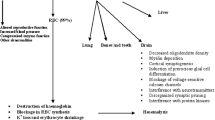Summary
Lead in liver, spleen and kidney of poisoned cattle is bound to substances containing ferric hydroxide. In liver and kidney the smaller amount of lead is sorbed by ferritin, the greater amount by insoluble ferric hydroxide. In the spleen ferritin and insoluble ferric hydroxide contain approximately the same amount of lead. The insoluble ferric hydroxide particles could be concentrated by digestion of insoluble liver proteins with phenol. They were not identical with hemosiderin. The sorption of lead ions and of other metal ions to ferritin and ferric hydroxide was investigated in vitro. Lead sorption is preferred over the sorption of other metal ions. Reaction of metal ions with the protein shell of ferritin occurred only with copper ions. The sorbed metal ions could be split from ferritin by high concentrations of other metal ions and strongly by hydrogen ions. It seems, that lead binding disturbs the storage of iron in tissues in lead poisoning.
Similar content being viewed by others
Literatur
JUBB, K. V. F. und KENNEDY, P. C. Pathology of Domestic Animals, Vol. 2, S. 334 (1963). Academ. Press, New York.
MOESCHLIN, S. Klinik und Therapie der Vergiftungen 4. Aufl. S. 46 (1964), Thieme Verl., Stuttgart.
ASONSON, A. L. und HAMMOND, P. B. J. Pharmacol. exper. Therap. 146, 241 (1964).
LANG, H. und FINGERHUT, M. Arch. exper. Path. Pharmacol. 235, 41 (1958).
IWANTSCHEFF, G. das Dithizon in der Mikro- und Spurenanalyse (1962), Verl. Chemie, Weinheim.
KALDOR, J. Austral. J. exper. Biol. 32, 795 (1954).
SPECKER, H. und TRÜB, H. Z. f. anal. Chem. 186, 123 (1962).
PAPADAKIS, J. Diss. Univ. Freiburg (1965).
BEHRENS, H. und TAUBERT, M. Z. f. physiol. Chem. 290, 156 (1952).
RÜSSEL, H. Dtsch. tierärztl. Wschr. 75, 313 (1968).
MAZUR, A., LITT, J. und SHORR, E. J. biol. Chem. 187, 485 (1950).
SETTLEMIRE, C. T. und MATRONE, G. J. Nutrit. 92, 153 (1967).
BUTT, E. M., NEUMANN, R. E., GILLMOUR, T. C. und DIDO, S. L. Metal Binding in Medicine, (herausgegeben von M. J. SeVEN und L. A. JOHNSON). S. 43 (1960). J. B. Lippincott Comp., Philadelphia.
UNDERWOOD, E. J. und MORGAN, E. H. Austral. J. exper. Biol. 41, 247 (1963).
Author information
Authors and Affiliations
Additional information
Die Deutsche Forschungsgemeinschaft unterstützte diese Arbeit durch Gewährung einer Sachbeihilfe. Fräulein B. Saacke sei für gewissenhafte Mitarbeit gedankt. Ferner danke ich den Herren Veterinärbeamten der Veterinärämter in Schieiden und Euskirchen für die Probenahmen.
Rights and permissions
About this article
Cite this article
Rüssel, H.A. Über die Bindung von Blei an eisenhydroxidhaltige Stoffe in Leber, Niere und Milz vergifteter Rinder. Bull. Environ. Contam. Toxicol. 5, 115–124 (1970). https://doi.org/10.1007/BF01617188
Issue Date:
DOI: https://doi.org/10.1007/BF01617188




